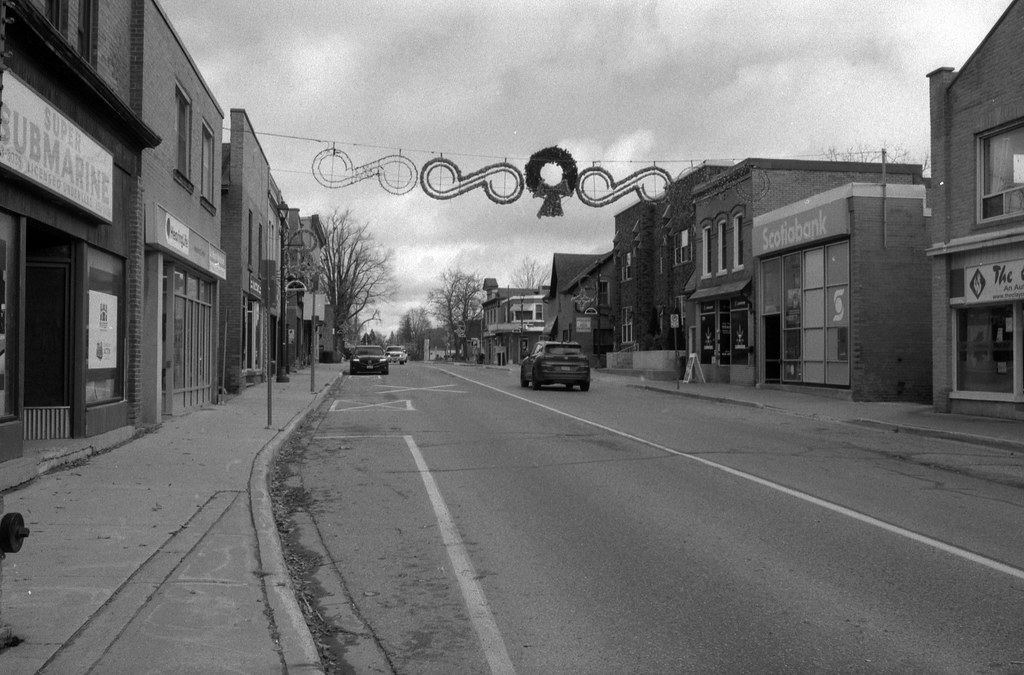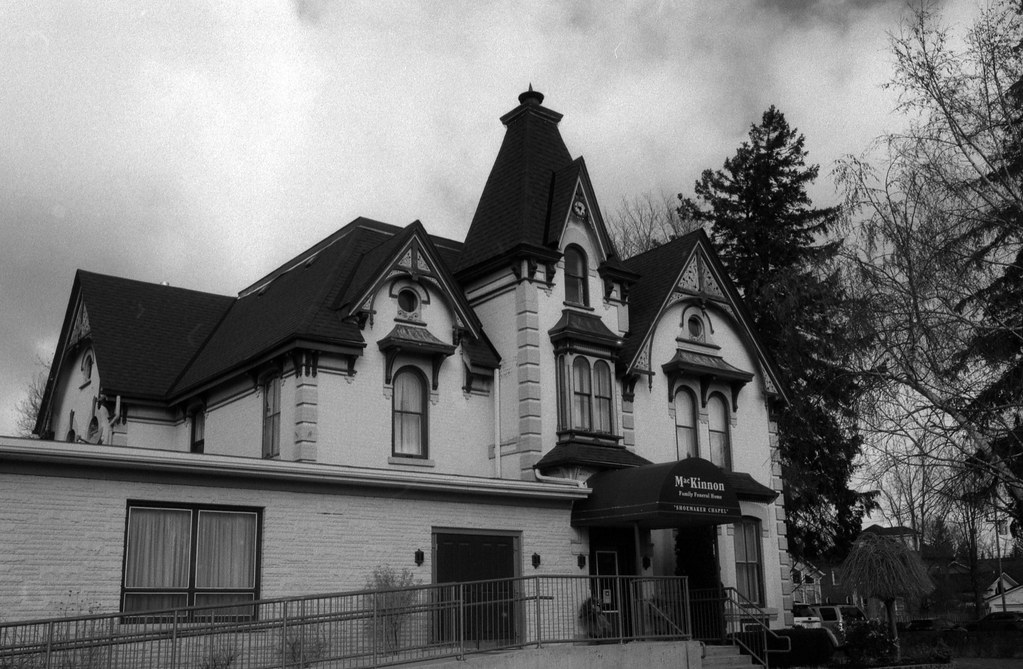There is an odd little feud running through the Halton region if you’re from my part of Ontario. And that feud focuses on three communities, Georgetown, Milton, and Acton. And while both Milton and Georgetown have managed to overcome some of their small town rural natures and sprawled into small cities, Acton has stayed small. And between the bitterly cold wind, the global pandemic, and the basis of living in Milton, downtown Acton also looked sad and felt that way.

Nikon FM – AI-S Nikkor 35mm 1:2.8 (Yellow-12) – New Classic EZ400 @ ASA-200 – Adox Atomal 49 (Stock) 9:00 @ 20C
The history of Acton has always been tied to the art of tanning leather. The first known humans to settle in the region were the Wyandot, who used the numerous spruce and hemlock trees for tanning the animal skins to create leather clothing. Although by the 1650s, the deadly Beaver Wars and sickness had driven them away, the land was then occupied by the Mississaugas of the Credit. Under Treaty 19 in 1818, the area was ceded to the Crown and surveyed for colonisation. It wasn’t until 1825 that three brothers arrived and established their farms. The Adams brothers, Rev Zena, Rev Ezra, and Rufus were retired Methodist preachers who could no longer take the stress of riding through the rural communities to conduct Sunday services. Eventually, a fourth brother arrived to build a farm of his own. Like any farming settlement, additional services soon began to come, the first being a dry goods store opened by Wheeler Green in 1828 at the opening of the York-Guelph Road (Today Highway 7); the small settlement became Dansville, named after a popular clerk in the Wheeler Store. Rev Ezra Adams opened a pair of mills by 1835, and a year later, the small settlement took the name Adamsville after the original settlers. Captain Abraham Nelles, recognising the raw materials to start a leather tannery, opened Adamsville’s first in 1842. Acton arrived in 1844 when Robert Swan opened the first post office and established mail delivery, taking the name from the neighbourhood he grew up in in London, England. The community received a significant boost when the Grand Trunk arrived in 1856 to push west towards Sarnia. And by 1861, the first school opened; four years later, the Beardmore family took over the Nellis Tannery and began a rapid expansion of the leather industry. Acton took the nickname leathertown in stride and embraced the industry despite the smell. The Beardmore Tannery provided the perfect chance for W.H. Storey, who arrived and established a glove factory in Acton to use the raw material. Storey became one of the community’s prominent citizens, and when Acton was incorporated as a village, it was Storey who was elected the first Reeve. Storey also completed a grand family home in 1879, Sunderland Villa (Still downtown today). The town continued to expand rapidly as both the Storey Glove factory and Beardmore Leather continued to grow, requiring a series of tenement houses to be constructed for the town’s workforce. A Village hall was completed in 1882, and electricity arrived at the turn of the century. The town’s leather industry provided a great deal of equipment through the first and second world wars, although in 1944, the tannery was sold to Canada Packers. Despite being incorporated as a town in 1950, it seemed Acton had peaked. The old Storey Glove factory came down in 1962 along with the town’s second post office. By 1974, Acton became a part of Halton Hills, and only through local intervention was the town hall saved in 1977. The biggest hit was the closure of the Beardmore tannery in 1986. Despite the loss of Beardmore, six years earlier, a trio of investors picked up an old warehouse that had been sold off in 1935 and reopened as a leather store known as the Old Hide House. One of the biggest and most iconic phrases has been attached to Acton since it came from the Old Hide House. It’s Worth the Drive to Acton.

Nikon FM – AI-S Nikkor 35mm 1:2.8 (Yellow-12) – New Classic EZ400 @ ASA-200 – Adox Atomal 49 (Stock) 9:00 @ 20C
Nikon FM – AI-S Nikkor 35mm 1:2.8 (Yellow-12) – New Classic EZ400 @ ASA-200 – Adox Atomal 49 (Stock) 9:00 @ 20C
Despite everything, there is still plenty to photograph in Acton, and there is a lot of historic architecture that has survived. Like any town I visit, the featured image is that of the downtown, Highway 7 in this case, looking east. The one thing that struck me is that most of the businesses are closed on Monday, either by choice or in general. There were a lot of shuttered storefronts. Of course, I couldn’t leave without including a couple of shots of the Old Hide House, an Acton staple since the 1980s, and the only surviving building from the original Beardmore Tannery. Sadly there’s nothing left of the Beardmore Tannery or the Storey Glove factory, but Sunderland Villa certainly cuts itself as the finest building in Acton’s downtown. Another set of impressive surviving 19th Century buildings are the Syndicate Houses of 1882, constructed by the local Union for the various workers who found themselves living in Acton. And the old town hall, which has seen a second life as a regional community hub. Surprisingly this time around, I found myself having a hard time deciding which images to include this week as there were a lot to choose from. Still, it helped lay out the town’s history first before digging in to have the included images that matched the historical narrative.

Nikon FM – AI-S Nikkor 35mm 1:2.8 (Yellow-12) – New Classic EZ400 @ ASA-200 – Adox Atomal 49 (Stock) 9:00 @ 20C
Nikon FM – AI-S Nikkor 35mm 1:2.8 (Yellow-12) – New Classic EZ400 @ ASA-200 – Adox Atomal 49 (Stock) 9:00 @ 20C
This week, I worked with Adox Atomal 49, a running favourite with Fomapan 400 that helps overcome some of the film’s less than ideal aspects. I probably should have gone with my initial thought and brought a 28mm lens, but after seeing the results, my trusty 35mm f/2.8 did the job nicely. While I did struggle with the narrow streets that make up the historical core of Acton, I’m happy with the compositions I did create. With partly sunny skies, I included a pale yellow filter on the lens to help with contrast and shot the film with a one-stop over-exposure shooting the movie at ASA-200.

Nikon FM – AI-S Nikkor 35mm 1:2.8 (Yellow-12) – New Classic EZ400 @ ASA-200 – Adox Atomal 49 (Stock) 9:00 @ 20C
Nikon FM – AI-S Nikkor 35mm 1:2.8 (Yellow-12) – New Classic EZ400 @ ASA-200 – Adox Atomal 49 (Stock) 9:00 @ 20C
Next week I’m heading back into Toronto for only the second time this project and taking a long walk from Danforth back into the downtown and looking at everything in between.